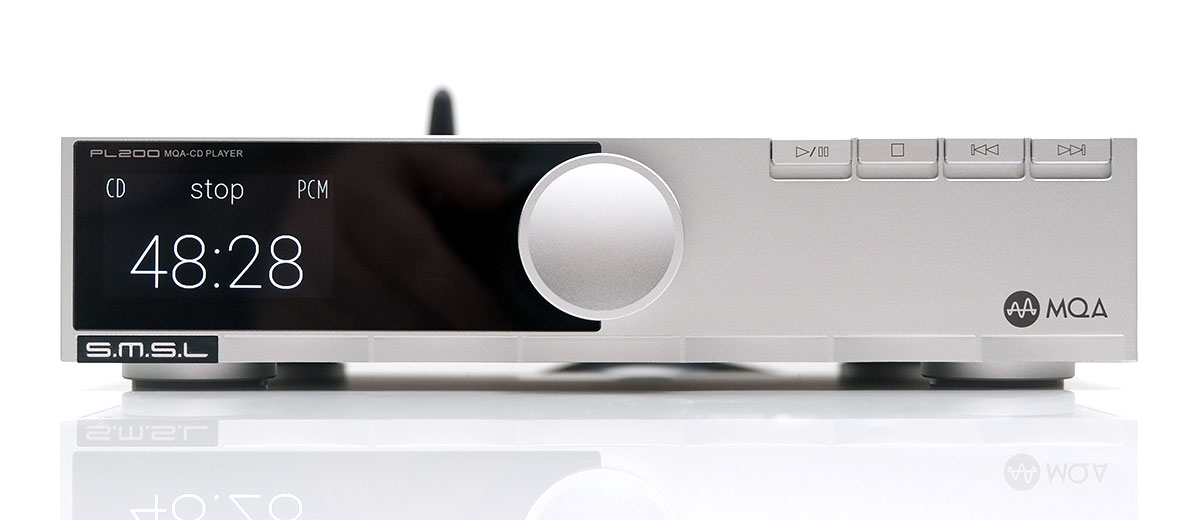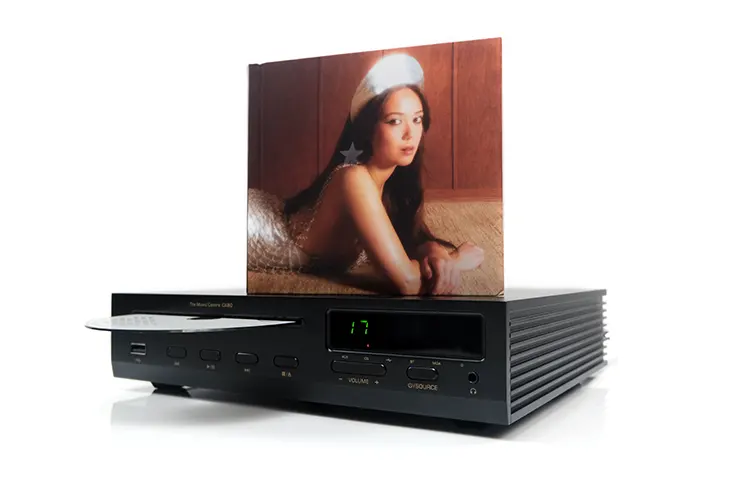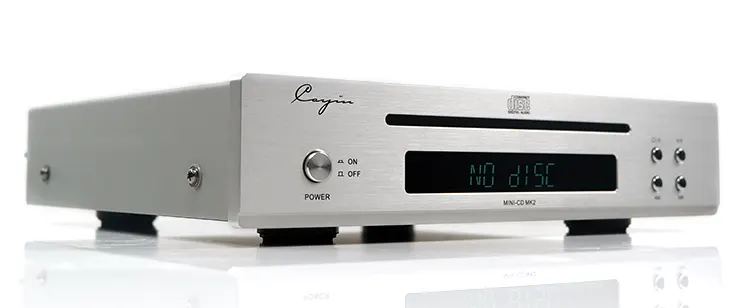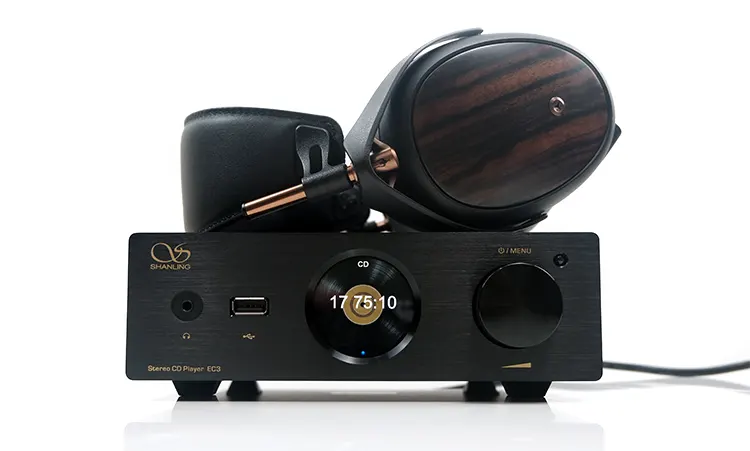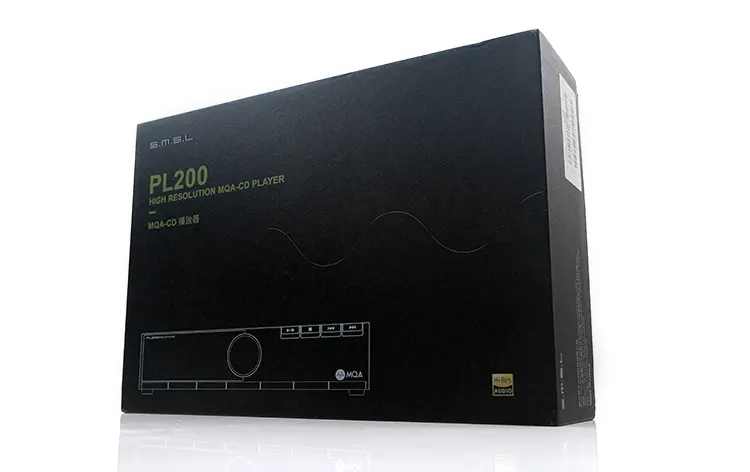Select Comparisons
The following selected comparisons were completed using a mix of the Ferrum OOR as the main amplifier for each player’s lineout combined with the Meze Audio Elite, PMG Audio’s Apx, and Vision Ears VE10 for my chosen headgear.
Shanling CA80
The Shanling CA80 was launched in 2023 with our review just published a few days ago. Its sibling is the CD80 and is similar in most aspects to the CA80 except for the speaker amplifier output.
Technical
SMSL has gone the in-house route with their top-loading P.A.S.S. or Precision Access Servo System compared to the CA80’s branded Philips CD tray and a Sanyo HD860 optical laser.
Top loading is a simpler design with fewer moving parts and, if done well, is less likely to scratch or fail leaving your CD stuck in the tray. The downside is that it is not stackable, meaning you need space over the top panel to insert the CD.
My experience with the PL200 top loader is that it is fast to read, loading CDs perhaps 5-6 seconds faster than the CA80, even allowing for the puck and lid placement time.
Both units can operate as a DAC. However, the PL200 has no local storage USB mount, interfacing like a regular DAC to PC/MACs with a USB-C interface on the rear panel.
It also has a higher-end AKM AK4499EX DAC, decoding up to PCM 32BIT/768kHz and DSD512 via USB. The CA80’s ES9219MQ DAC delivers a lower PCM 32BIT/385kHz and native DSD256.
Both have BT5.0 modules up to LDAC though the CA80 lacks aptX. The key advantage of CA80 when going wireless is the Eddict app integration for both media and BT. This gives you more flexibility to place the player anywhere without a USB cable for media playback.
Both units offer amplification for IEMs and earphones but the PL200’s rear output 6.35mm design makes it clear this is a secondary option. It also has no direct-to-speaker amplification.
The CA80’s front panel 3.5mm TRS output placement is more accessible but much weaker at 130mW into 32Ω compared to 1W for the PL200.
The PL200 offers both SE and balanced variable and fixed lineout on the rear panel but I am presuming 2/4Vrms split as there is no voltage specification for either in the user manual.
Design
Both players have some beautiful retro styling though both have gone very different routes to achieve that look.
The SMSL is far smaller and lighter, making it a neat device to stack on top of a device whereas the CA80 is more the device to be stacked on top of. The top loader system though means the PL200 does need to be on top regardless.
The PL200 only comes in silver with no black option but I think it stands out much better in the silver format. Nuanced design accents might get lost in a black finish. The vintage black with the digital tube glow of the CA80 suits its vibe perfectly.
The SMSL styling is very noire to me with its thin tall font on a very legible IPS panel on the front combined with a two-tone finish on the front panel. I love the physical buttons on the right side, a genuine nod to an older era of mechanical buttons.
The physical buttons are also multifunction capable allowing you to change the various player modes, CD, DAC, and BT, thus further enhancing the player’s ease of use.
I also prefer the volume dial on the front of the PL200 as opposed to the manual rocker of the CA80. It’s faster to cycle through the volume levels with additional multifunction capability allowing you to dive deeper into the player’s extensive menu system to access many sound-shaping options.
Both units come with plastic but capable remote controls. My only critique is the CA80 remote’s lack of track-select numbered buttons, a feature that the PL200 version offers.
Performance
The PL200 from the PO and the LO is more neutral and slightly brighter when compared to the warmer, weightier coloration from the CA80.
That is not to say the CA80 is dark. Rather its strongest treble presence sits a little more on the lower mids whereas the general harmonic balance of the PL200 is lighter on the lows and stronger on the upper order.
This creates a perception of less note body, a lighter fundamental, and more contrast on instruments and vocal timbre from the PL200.
From the PO, the CA80 produced a natural fuller tone for me and was far more suited to classic rock and metal CDs, especially 80s rock CDs that I tend to find have a stronger digital sound.
Combined with heavier percussion presence and guitar mixes the presentation can ring bright and sharp on the PL200 with mid-forward head gear. The CA80 offered a more balanced and easy to listen to sound quality with better depth and vocal smoothness.
Gear matching here for the PO is more towards warmer IEMs with the PL200 sounding great with the Fathom and the VE10 and more neutral IEMs such as the Apx finding a home with the CA80.
The PO of the PL200 did much better with the advantage of the balanced output creating more space and channel separation compared to the CA80’s more intimate imaging.
A smoother and warmer amplifier such as the Gustard H26 is a nice match with the PL200. You still do not have the same bass weight or strong vocal presence from the CA80 but the treble sounds more tempered and soothing with headphones such as the Austrian Audio Composer.
Cayin Mini-CD MK2
The Cayin Mini-CD MK2 was launched at the tail-end of 2022 and is the cheapest of the compared players in this lineup. It’s been a staple in my office setup for about 8 months as a personal purchase.
Technical
The Mini-CD MK2 is closest to what I would call a pure CD player. This is not a transport, it does have a DAC chipset, with an older ES9018Q2M compared to the PL200’s AK4499EX but it has a nice upsampling capability that affects the performance.
There is no headphone amplification inside the Mini-CD MK2, it lacks wireless capability with no USB interface to receive an incoming signal from a digital source. Your source is your CD and decoding is via an analog SE 2V dual RCA, I²S, and a digital coaxial output.
I wish the PL200 had I²S also as it allows you to connect the player to a 3rd party DAC with a compatible I²S socket and transport a digital signal at a higher rate when compared to SPDIF.
Since there is no USB-DAC interface the Mini-CD MK2’s DAC is limited by the default 16BIt/44.1kHz for most CDs. To get around that and optimize the potential of the DAC, Cayin has introduced an upsampling feature capable of up to 352.8 kHz.
This still falls short of the PL200’s DAC and its 32BIT/768kHz decoding capability but as far as I am aware the PL200 cannot upsample a CD sample rate so you will only get the default rating of that CD.
The Mini-CD MK2 uses a slot-loading mechanism and a Sanyo laser which is not as fast to load and read the discs as the top-loading P.A.S.S. system inside the PL200.
I have also been less than impressed with the Mini-CD MK2 loading performance. Quite often the CD will slide in but fail to mount and be read forcing me to reboot and hit open right after to eject the CD.
Design
There is nothing wrong with the Mini-CD MK2 design, it fits the bill for a simple desktop CD player with a stylish brushed aluminum front panel finish and a nice dot matrix style LCD panel that reminds me of 90’s CD players.
However, place it beside the PL200’s mix of modern and retro and it starts to look a bit more HiFi generic. Those visible screws on its slightly larger housing stick out by a county mile when ranged against the solid, seamless aluminum block of the PL200.
Throw in those classy piano-styled mechanical keys, a big legible IPS panel, and an intuitive multifunctional dial in the middle then it’s hats off to the PL200. This is how it should be given the price difference between these two desktop players.
Since the PL200 is loaded with more features the I/O lineup on the rear panel is more complex than the Mini-CD MK2.
Both have dual RCA SE and a coaxial output but where they diverge is the inclusion of a balanced XLR and an optical output with USB-C for OTG and USB-DAC functionality on the PL200. The Cayin’s I²S is its one clear advantage for digital outputs.
Both come with plastic remote controls. Nothing fancy here but I give both companies credit for including track selection numerical grids to quickly select the track you want to play.
Performance
Since the Mini-CD MK2 is a lineout player I hooked both up to the Ferrum OOR via RCA for this comparison using the Abyss Diana MR and the Vision Ears VE10.
The first thing that leaped out was the lineout dynamism itself. The dynamic range from the PL200 lineout is the better of the two players sounding more open, punchier, and clearer.
The Mini-CD MK2 staging sounded somewhat shrunken when volume-matched. It is not just a question of fiddling with the variable volume lineout of the PL200 to get a similar loudness level, rather the Cayin’s separation and resolution were a step behind in general.
I heard a tonal quality not too far off each other through the mids with the PL200 showing off more upper treble presence and headroom. Vocals notes hit with more physicality on the SMSL player whereas via the Mini-CD MK2, they are a little leaner, struggling to sound as vivid and resolving.
On the lows, the impact and definition were better from the PL200 performance with both the VE10 and the Diana MR. There was also just a hint more weight and density from the PL200 through the mid-bass which surprised me considering I felt the PL200 was fairly neutral to begin with.
Again, I am just putting that down to their respective lineout performance with the Cayin’s fixed LO seeming less aggressive compared to the SMSL’s equivalent SE dual RCA.
Shanling EC3
The Shanling EC3 was launched in late 2022 with a similar price tag to the PL200. This CD player will also be reviewed in due course so consider this comparison as some early impressions.
Technical
Both units are top-loading desktop CD players with headphone amplification, Bluetooth receiving, and a DAC with lineout capability. If anything, the EC3 feels like a grown-up EC-Mini in terms of features and the M-Touch GUI styling.
The EC3 transport runs a familiar Shanling path with the outsourced but very reliable Philips CD80 drive mechanism and Sanyo HD850 laser head. SMSL has gone a different way with their in-house P.A.S.S. servo system.
They are both equally fast and accurate for reading discs and playback. I clocked them both at around 3-4 seconds for loading, reading, and preparing the same disc for playback once the lids were attached.
The PL200’s AK4499EX DAC is a step up on the EC3’s ES9219C with 14 dB more dynamic range from the SMSL balanced line out and 12 dB more when measuring both players’ SE analog equivalents.
The chipset performance difference for USB-DAC duties is also noticeable with a maximum of 32BIT /384kHz and DSD256 natively from the EC compared to the PL200’s more capable DSD512 and PCM 32BIT/768kHz rates.
I would say PL200’s BT is also more competitive with the inclusion of aptX and apt HD, a codec range not included in the EC3 though arguably most will opt for LDAC decoding which is available on both units in receiving mode.
Headphone amplification is very weak on the EC3 at just 20mW(low gain) and 70mW(high gain) into a 32Ω with a 3.5mm TRS output. It’s nowhere near the SE 1W x 2 maximum rating from the PL200’s 6.35mm output.
Lineouts seem to be the same for SE, perhaps even better for the EC3 at 2.3Vrms SE though it lacks the PL200’s balanced output option which should be rated around 4Vrms.
Design
The EC3 follows a similar design language to other compact desktop devices in the Shanling range such as the EM5. It’s a relatively uniform medium-sized component system and certainly a lot bigger and taller than the diminutive PL200.
Aesthetically, no question the PL200 is the standout in this comparison. I suspect if the EC3 sample here were a silver version (they come in black and silver) there would be some synergy side by side but as it is, the EC3 black unit is classic HiFi to me and perhaps more muted in its design.
There is plenty of space on the top panel for both of their top loading systems and while each has an excellent top panel button system I prefer the PL200’s piano-key functionality for easy operation when looking at the unit head-on.
The Shanling button system is somewhat similar in functionality but it’s flush with the top panel meaning you have to stand over it to see the labels if you plan to operate it manually.
Both can be operated manually with the EC3 coming with a much higher grade pin battery-equipped metal case remote control that feels more durable than the cheaper plastic of the PL200. The only problem is the lack of a numerical grid on the EC3 remote for track selection.
The Shanling EC3 uses a good quality IPS display panel but the circular enclosure reduces the legible real estate compared to the square PL200 panel.
The EC3 is SyncLink compatible with a USB-A slot on the front panel to load local media for local playback. The device can be operated via BT from your phone which the PL200 lacks. However, it lacks the PL200’s USB-DAC functionality and balanced XLR outputs.
Performance
For headphone amplification, the EC3 leans a little dense on the lows with a bit more warmth through the mid-bass and lower-mids. The PL200 is more neutral in low-end weight with tested IEMs such as the VE10 and PMG Audio Apx.
You get a similar contrast through the mids but with vocal imaging on the PL200 just a little further back in the mix whereas the EC3 pushes them further forward but not quite as forward-sounding as the CA80 presentation.
I wouldn’t describe the EC8 as natural sounding as the CA80 and overall, it’s closer to neutral with a bit of a jump in energy through the lower mids with my tested IEMs.
The PL200 has more treble extension and presence so higher pitching percussion is more ‘fragrant’ for one of a better word. In short, plenty of energy and presence.
The above might seem the EC3 might be the preferable PO output tonally but technically the PL200 is ahead in terms of dynamic range and channel separation. Overall, the PL200 seems more resolving though it carries a heavier tonal contrast that can create a stronger perception of detail.
I find the PL200’s staging width and height the better of the two players. The EC3 does better in terms of low-end weight which suits the VE10 but if you want to enhance the perceived instrumental separation throughout with more headroom the PL200 is my preferred choice.
With the LO it’s a similar pattern with the EC3’s natural denser tone finding a more natural home with neutral amplifiers such as the Ferrum OOR and the PL200’s cleaner presentation doing better with warmer or denser alternatives such as the HIFIMAN Serenade.
My Verdict
The SMSL PL200 is every bit a capable CD player for the modern audiophile. It has a healthy mix of external retro styling combined with a pleasingly fast disc reader and a wide range of features that go beyond just playing CDs.
Technically, its performance is excellent with impressive imaging and solid dynamics, all backed up by an unusually powerful headphone amplifier for a CD player.
Tonally, there will be those who love its clean and clear sound signature but for others, it is a try before you buy.
It’s not as natural or smooth-sounding as some competing players when paired with brighter headphones and IEMs but sounds excellent with gear I would describe as inherently warm-sounding.
Overall, it’s a competitive little top-loading CD player, and if given enough rack space it’s also a bit of eye candy that should be a conversation piece for those with an observant eye.
SMSL PL200 Technical Specifications
- Input: CD/Bluetooth/CD player
- Output: RCA/XLR/Headphone
- THD+N: 0.000068%(-123.5 dB)(UN-WTD)
- Dynamic range XLR: 132 dB RCA: 127 dB
- SNR XLR: 132 dB RCA: 127 dB
- Headphone output power: 1000mW × 2 (32Ω)
- USB transmission: USB 2.0 Asynchronization
- USB compatibility: Windows 7 / 8 / 8.1 / 10 / 11(needs driver) Mac OSX 10.6 or later, Linux (driverless)
- Sampling rate PCM: 44.1 – 768kHz DSD: 2.8224 – 22.5792MHz
- Bluetooth specs: 5.0 (Supports SBC, AAC, aptX, aptX HD, LDAC)
- Power consumption: 10W
- Standby power: <0.5W
- Size: 7.87” x 1.6” x 6.8” (200mm x 42mm x 175mm)
- Weight: 3.74lbs

